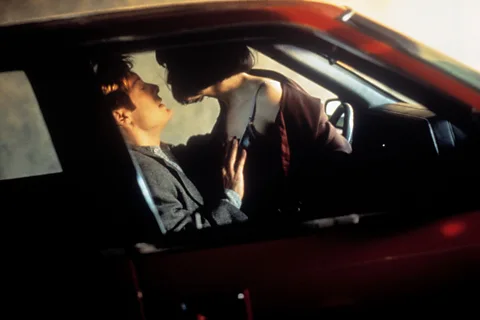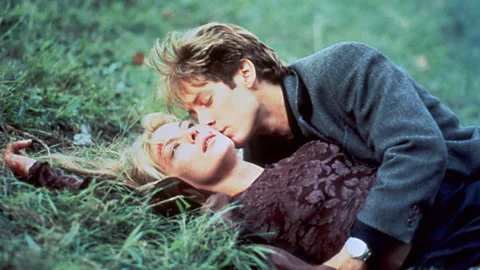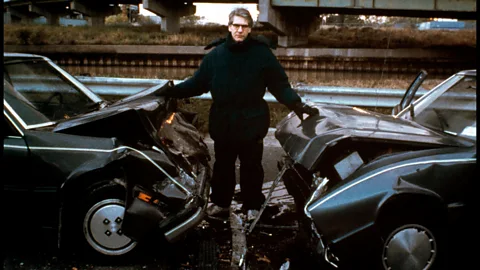Why twisted erotic thriller Crash still stuns, 25 years on
 Alamy
AlamyDavid Cronenberg caused hysteria with his take on J G Ballard's novel about car crash fetishists. While it is less controversial now, it startles nevertheless, writes Arjun Sajip.
On Monday 3 June 1996, any Londoner who picked up a copy of the Evening Standard newspaper on their way home from the office would have paused when they reached the headline: "A movie beyond the bounds of depravity".
These words accompanied a fiery full-page diatribe penned by the Standard's film critic, Alexander Walker, deploring David Cronenberg's latest film Crash – an adaptation of the JG Ballard novel about a group of people who derive sexual pleasure from car crashes – in the strongest possible . An august commentator who had held his post at the Standard for 36 years, Walker was no prude: he had been an outspoken critic of censorship and a staunch defender of Stanley Kubrick's controversial 1971 film A Clockwork Orange, among other things.
More like this:
– Why Titane is 2021's most provocative film
So how could such a seasoned and liberal critic find a film so objectionable – so unopen to interpretation – that he argued it shouldn't be seen? Was this simply a case of a critic turning reactionary with age? Or was there something profoundly disturbing – and potentially harmful – about David Cronenberg's Crash?
 Alamy
AlamyTwenty-five years on from Crash's original release, it is undoubtedly still a startling work that contains deeply challenging, even confrontational themes, and presents them in an intense, controlled, uncompromising way. For a start, the film's first scene is a sex scene. So is its second scene. And its third. When viewed for the first time, especially in a cinema, it feels discomfiting: partly because you're never quite sure when the onslaught of copulation will end, and partly because the third scene reveals that two of the lovers shown with different partners in the previous ones are in fact a husband and wife, James and Catherine (James Spader and Deborah Kara Unger). Their sexual satisfaction comes from recounting that day's infidelity while having sex on a balcony overlooking a highway.
That highway is Highway 401, the Toronto section of which is, in real life, the busiest highway in North America, and so infamous for crashes that one section has been dubbed Carnage Alley. You wouldn't know this from watching Crash: the flow of cars below James and Catherine's apartment, filmed in evening hues with an uncanny sumptuousness by cinematographer Peter Suschitzky, is regular, predictable, entirely conventional.
But a violent crash is what kicks off the film's plot. James loses control of his car during a night-time drive and swerves down a verge into oncoming traffic, driving into the blinding lights until his car crashes head-on into another. That car's enger is flung headfirst through James's windshield, dying instantly. Stunned, James looks at the driver of the other car. It is a sharp-faced, brunette-bobbed stranger, Helen (Holly Hunter), whose natural reaction, upon seeing the author of her husband's death, is to remove her seatbelt and flash her breast to him.
Clearly it isn't just James and Catherine who are sexually deviant; it is a feature of the film’s world. Helen, whose attraction to James after their accident is very much mutual, inducts him into a group of car-crash fetishists led by Vaughan – by far the most sensuous and alive character in the film, and the figure around whose mysterious project the group coalesces. The final key figure to be introduced is Gabrielle (Rosanna Arquette), a mischievous young disabled woman with callipers clamped tightly around both her legs, who has been part of the group for some time, and who has a deep vulva-shaped scar on her thigh.
Throughout the many sex scenes that follow, almost every possible permutation of couplings is realised. James and Helen. James and Gabrielle. Vaughan and Catherine. Vaughan and James. Helen and Gabrielle. The scenes are never explicit in a hardcore sense, but neither are they shy. The cars themselves come to play an increasingly significant role in the sexual logistics – stationary at first, then moving slowly through a car wash, and then, as Vaughan’s project approaches its endpoint, at high speed on the streets.
What is Vaughan's project? Nothing more, and nothing less, than the ultimate merging of sex and car crashes – or the merging of sex and car crashes with the ultimate. If the French term for "orgasm" translates to "little death", Vaughan's dreams of sexual satisfaction are bigger: a grand death, with squealing tyres, crashing fenders, spinning wheels and shattered glass.
 Alamy
AlamyThe root of its disturbing power
Late in the film, Vaughan delivers the line that, more than any other, sealed Crash's fate as a potentially offensive work: "the car crash is a fertilising rather than a destructive event – a liberation of sexual energy that mediates the sexuality of those who have died with an intensity impossible in any other form."
Automobile accidents were nothing new in cinema, and indeed a wide range of films – from Bonnie and Clyde to Weekend to Badlands – had drawn links between cars, liberation, sex and death. These films can be described as "existential romances", which is also how Cronenberg described Crash. But while those three films and so many others have romanticised their protagonists, setting them against fusty authority figures or – in the case of Badlands – allowing the characters to romanticise themselves to each other, Crash is disturbing because it redraws the boundaries of what we might consider romantic. It takes conventional Hollywood erotic potential – the ethereally sensual performance of Unger and the boyishly handsome, leather-jacketed Spader – and puts it through the wringer, making us watch until our usual responses to sex in cinema have been exhaustively deconstructed. It doesn't just posit the deeply unsettling idea that car crashes can be "fertilising rather than destructive"; it explores this argument in good faith. That's what makes the film so disturbing.
Most surprising of all, this was not an abstract intellectual exercise for either Ballard or Cronenberg: it was deeply personal. The protagonist's full name in both novel and film is, in fact, James Ballard, and Ballard the writer once described Crash as more autobiographical than his actual memoir, Empire of the Sun. "These were my fantasies," said Ballard at a live interview event hosted by the Guardian around the release of the film, when asked why he named the character after himself; it gave the novel "a degree of honesty that would be absent otherwise".
Meanwhile, when pondering what brought on the urge to make a film of the novel, Cronenberg, a certified motorhead, said that the novel "had started a process in me that I could only complete by making a film of it, because that is my only means of exploring my reactions to things, and my understanding of my own life".
But the story of Crash's origins stretches back farther than the novel. In 1970, three years before the novel was even published, Ballard unveiled a controversial three-week exhibition titled Crashed Cars at the New Arts Lab in London, which featured the three titular structures simply on display. The following year, he starred in a short experimental film titled Crash! for the BBC's Review series. Although it was inspired by a chapter from his previous novel, The Atrocity Exhibition, it already contains the seeds of Crash – not just Ballard's transfiguration of himself into his art, but a deeply thought-through meditation on the metaphysics of car crashes and the role of the car in the modern world.
"The 20th Century reaches its highest expression on the highway," says Ballard in the film. "Everything is there: the speed and violence of our age, its strange love affair with the machine, with its own death." He goes on to ask in what many might judge an extreme provocation, "Are we just victims in a totally meaningless tragedy, or does it in fact take place with our unconscious and even conscious connivance? Each year, hundreds of thousands are killed in car crashes all over the world. Are these arranged deaths? Arranged by the colliding forces of our technological landscape, by our own unconscious fantasies about power and aggression">window._taboola = window._taboola || []; _taboola.push({ mode: 'alternating-thumbnails-a', container: 'taboola-below-article', placement: 'Below Article', target_type: 'mix' });
